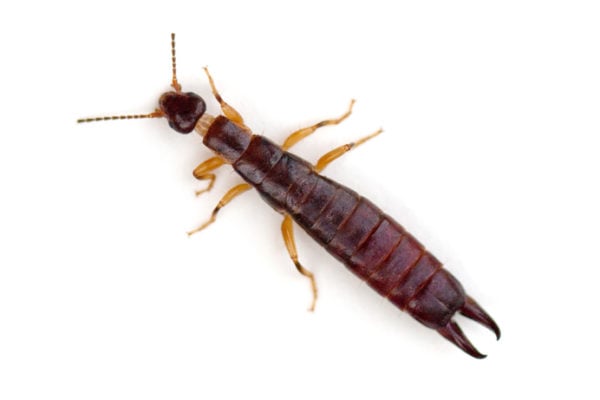Earwig Pest Control

BEHAVIOR
Earwigs prefer a moist environment, but the most common reason earwigs end up indoors is that the ground has become too saturated with water and they need to seek a slightly drier area in which to survive. Earwigs prefer to remain outdoors where they typically have everything they need to survive and thrive. However, they will be drawn indoors sometimes by mistake, or when, as stated, the ground gets too saturated, or in the fall when they are seeking a warmer climate in which to spend the winter.
Because of their intimidating pincers protruding from their lower abdomen, earwigs might appear to be dangerous, but they are not. Earwigs could use their pincers to grasp onto a finger if agitated, but earwigs do not sting, nor are they dangerous. They have no venom, so earwigs are not poisonous.
In ancient times, it was believed that these insect crawled into the ears of unsuspecting people while they slept, and fed upon their brains. There is no truth to this myth. Closer to the truth is the likelihood that they got their name because their wings, when spread, mimic the shape of the human ear.
CONTROL AND PREVENTION
The most important part of keeping earwigs out of a house is to make conditions inhospitable for their success. On the exterior, remove as much plant debris and mulch as possible from around buildings. If moisture problems are created by improper drainage (such as poorly ducted downspouts or inadequate grade slope), these conditions need to be corrected. Firewood should be kept as far from the house as practical. On the interior, keep basements free from moist conditions, leaching or standing water and repair cracks and crevices in the foundation.
More intensive pest control measures include treating the interior of the home with a targeted application of an approved insecticide to eliminate the earwigs that are present. On the exterior, a protective barrier can be provided to the immediate exterior of the home by treating from the foundation out to about 6 feet, and also treating cracks and crevices on the foundation.
Since earwigs prefer the moist areas in and around decaying vegetation, the best way to control earwigs is to modify that wet and comfortable environment.
On The Exterior: remove as much plant debris and mulch as possible from around buildings. If moisture problems are created by improper drainage (such as poorly ducted downspouts or inadequate grade slope), these conditions need to be corrected. Firewood should be kept as far from the house as practical.
On The Interior: keep basements free from moist conditions, leaching or standing water and repair cracks and crevices in the foundation.
Since earwigs prefer the moist areas in and around decaying vegetation, the best way to control earwigs is to modify that wet and comfortable environment.
APPEARANCE
Of the several species of earwigs that could occur in the United States, the European earwig is the one that is seen most frequently in our area. They are 5/8” long with flattened, elongated bodies that are dark brown in color. Earwigs are characterized by the cerci, or the pair of forceps-like pincers on their lower abdomen. These pincers are used to capture prey, defend themselves, and fold their wings. Earwigs have hindwings and are capable of flight, but they very rarely fly.
Earwigs are most often found under rocks, logs, and dead leaves outside. Inside, they hide in basements, under rugs or furniture, behind baseboards, in floor drains, or just about any place that is moist, dark and cool. Earwigs are active at night. During the day they hide in cracks in damp areas.

PROFESSIONAL CONTROL
Plunkett’s Pest Control specialists are ready to control, prevent, and wipe out Earwigs.
If you have an Earwig infestation in your home or business, Plunkett’s is the best service to call.






